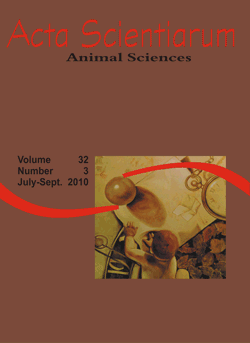<b>Prediction of genetic values using bayesian inference and frequent on simulated data</b> - doi: 10.4025/actascianimsci.v32i3.7862
Keywords:
heterogeneity of variance, variance components, simulation, priori information
Abstract
Simulated data were used to compare EBLUP and Bayesian methods in data with homogeneity of variance, heterogeneity of variance and genetic heterogeneity of genetic and environmental variance. For these structures were strategic disposal of additive genetic and environmental values in accordance with the type of heterogeneity and the desired level of variability: high, medium or low. We used two sizes of population: large and small. For the Bayesian methodology was used three levels of a priori information: no information, just information and informative. For verification of the introduction of different levels of information they were used the mistake percentage in relation to the true value of the variance components the Spearman correlation and the medium square of the mistake among the real genetic values and predicted them. The presence of heterogeneity of variances cause problems for the selection of the best individuals, especially if the heterogeneity is present in the components of genetic variance and environmental and animals are mistakenly selected the more variable environment. The methods presented similar results when compared not informative priors were used, and the populations of large size, in general, showed better prediction of breeding values. Was observed for the Bayesian methodology, the increase in the level of a priori information positively influences the predictions of genetic values, especially for small populations. The Bayesian method is preferred for populations of small size when there is availability of informative priors.Downloads
Download data is not yet available.
Published
2010-09-02
How to Cite
Carneiro Júnior, J. M., Assis, G. M. L. de, Euclydes, R. F., Martins, W. M. de O., & Wolter, P. F. (2010). <b>Prediction of genetic values using bayesian inference and frequent on simulated data</b> - doi: 10.4025/actascianimsci.v32i3.7862. Acta Scientiarum. Animal Sciences, 32(3), 337-344. https://doi.org/10.4025/actascianimsci.v32i3.7862
Issue
Section
Animal Breeding and Reproduction
DECLARATION OF ORIGINALITY AND COPYRIGHTS
- I Declare that current article is original and has not been submitted for publication, in part or in whole, to any other national or international journal.
The copyrights belong exclusively to the authors. Published content is licensed under Creative Commons Attribution 4.0 (CC BY 4.0) guidelines, which allows sharing (copy and distribution of the material in any medium or format) and adaptation (remix, transform, and build upon the material) for any purpose, even commercially, under the terms of attribution.
Read this link for further information on how to use CC BY 4.0 properly.
0.9
2019CiteScore
29th percentile
Powered by 








































